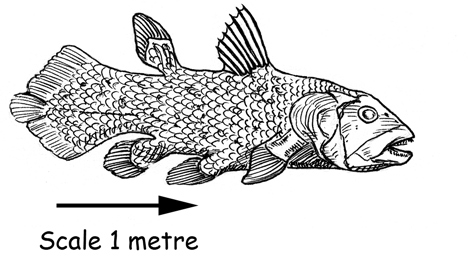Visiting the Liverpool World Museum is always a delight. Amongst the exhibits there is a small section that highlights the evolution of tetrapods. There is a stunning coelacanth specimen on display. Coelacanths are sometimes referred to as “living fossils”. They are lobed-finned fishes (Sarcopterygii) in the class Actinistia. Their fossil record dates back to the Devonian. The last of their kind was thought to have become extinct at the end of the Cretaceous. That was, until December 1938, when a coelacanth was caught by a fisherman off the east coast of South Africa close to the Chalumna River estuary.

A stunning coelacanth specimen on display at Liverpool World Museum. Picture credit: Everything Dinosaur.
Picture credit: Everything Dinosaur
The Significance of the Coelacanth Specimen
The coelacanth display is part of a larger exhibit that highlights the evolutionary transition of vertebrates onto the land. As these fish have fleshy, lobe-like fins it had been thought that the coelacanth might be the youngest diverging non-tetrapod sarcopterygian. However, the genome of this fish was sequenced in 2013, and it was discovered that lungfish are more closely related to tetrapods.
To read about the sequencing of the coelacanth genome: The Coelacanth Gets Its Genome Unravelled.
Picture credit: Everything Dinosaur
Liverpool World Museum is a great place to visit. If you go, please take a look at the coelacanth display. It is a wonderful way to connect with a group of creatures that have been around since the Devonian.
Several models of coelacanths have been produced. For example, both the Mojo Fun and Safari Ltd ranges include coelacanth figures.
For prehistoric animal models visit the Everything Dinosaur website: Prehistoric Animal Models.



Leave A Comment